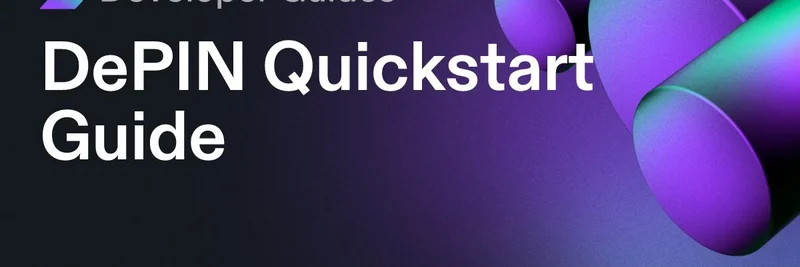Hey there, fellow blockchain enthusiasts! If you're into building on Solana or just curious about the next big thing in decentralized tech, you've probably caught wind of the recent buzz from the Solana Developers team. They just dropped an updated version of their DePIN Quickstart Guide, and it's packed with practical advice for anyone looking to create Decentralized Physical Infrastructure Networks (DePIN). Let's break it down in simple terms and see why this could be a game-changer for developers and meme token creators alike.
The announcement came via a thread on X from @solana_devs, highlighting the makeover of the Solana DePIN Playbook. This guide isn't just fluff—it's a hands-on resource that walks you through essential strategies for building DePIN projects on Solana. Whether you're structuring rewards or optimizing costs, it's designed to help you get started quickly and efficiently. You can jump right into it here.
Understanding DePIN: The Basics
First off, what exactly is DePIN? Short for Decentralized Physical Infrastructure Network, it's all about using blockchain to crowdsource and manage real-world infrastructure. Think wireless networks, data storage, or even mapping services, but powered by a community of participants incentivized with tokens. Instead of relying on big corporations, DePIN lets everyday folks contribute hardware or services and get rewarded for it. Projects like Helium (which migrated to Solana) are prime examples, showing how this model can disrupt traditional setups.
The beauty of building DePIN on Solana? It's fast, cheap, and scalable. Solana handles thousands of transactions per second at a fraction of the cost—around 0.00025 SOL per transaction. Plus, with tools like the Anchor framework and oracles from Pyth or Switchboard, you can cut down on development time and focus on innovation.
When to Use Blockchain in Your DePIN Project
The guide smartly advises not to shove everything onto the blockchain. Data storage, for instance, can get pricey, so store big files off-chain on platforms like Filecoin and use blockchain mainly for rewards distribution. This keeps things secure and efficient, leveraging Solana's strengths in handling small, frequent transactions tied to contributions.
Structuring Rewards Distributions
Rewards are the heart of any DePIN— they motivate participants to join and contribute. The playbook dives into how to mint and manage tokens effectively. Start with points systems before launching your actual token to test the waters and iron out bugs. For minting, stick with the standard Token program unless you need advanced features from Token22.
Tools like Forgd help model your token economy, while services such as Squads or Fireblocks handle treasury management with multi-sig security. And for staking? Integrate with Jito Network to create custom proof-of-stake mechanisms, ensuring participants have skin in the game.
Compressed Accounts: Cutting Costs by 50% or More
One of the standout features in the update is compressed accounts, which can slash your costs dramatically—over 50% in many cases. How? By using state compression techniques like Merkelization and compressed NFTs (cNFTs), you minimize the storage and rent fees for accounts. For example, minting a million NFTs on Solana now costs around $110 thanks to this tech.
In DePIN contexts, this means you can handle massive volumes of reward recipients without breaking the bank. It's all about hashing data into compact structures (like Merkle trees) and verifying states on-chain efficiently. If you're dealing with high-scale operations, this is a must-explore feature.
Proof-of-Contribution Consensus Without Full Data Persistence
Another key highlight is implementing proof-of-contribution (PoC) consensus. DePINs need reliable ways to verify participant contributions without storing every bit of data on-chain. Solana's Proof of History (PoH) comes in handy here, providing a cryptographic timeline that ensures everyone agrees on event orders without heavy data loads.
For instance, in networks like Helium, PoC might verify coverage or bandwidth. On Solana, you can use oracles or verifiable proofs to log contributions, calculate rewards, and distribute them securely. This avoids the pitfalls of full-data persistence, keeping your network lightweight and performant.
Why This Matters for Meme Token Builders and Beyond
While DePIN might sound more "serious" than your typical meme token frenzy, there's overlap. Meme communities thrive on engagement and rewards—imagine using DePIN principles to build community-owned infrastructure, like decentralized content delivery for viral memes or token-gated hardware networks. Solana's low costs and speed make it ideal for experimenting with these ideas, potentially turning fun projects into sustainable ecosystems.
If you're a developer or blockchain practitioner, this guide is your shortcut to staying ahead. It emphasizes practical steps, from choosing Solana over rolling your own chain (spoiler: it's usually not worth the hassle) to integrating ready-made tools for a smoother build.
Ready to dive in? Head over to the Solana DePIN Quickstart Guide and start building. Who knows—your next project could be the DePIN that powers the next wave of meme magic on Solana. What do you think—excited to try compressed accounts? Drop your thoughts below!


